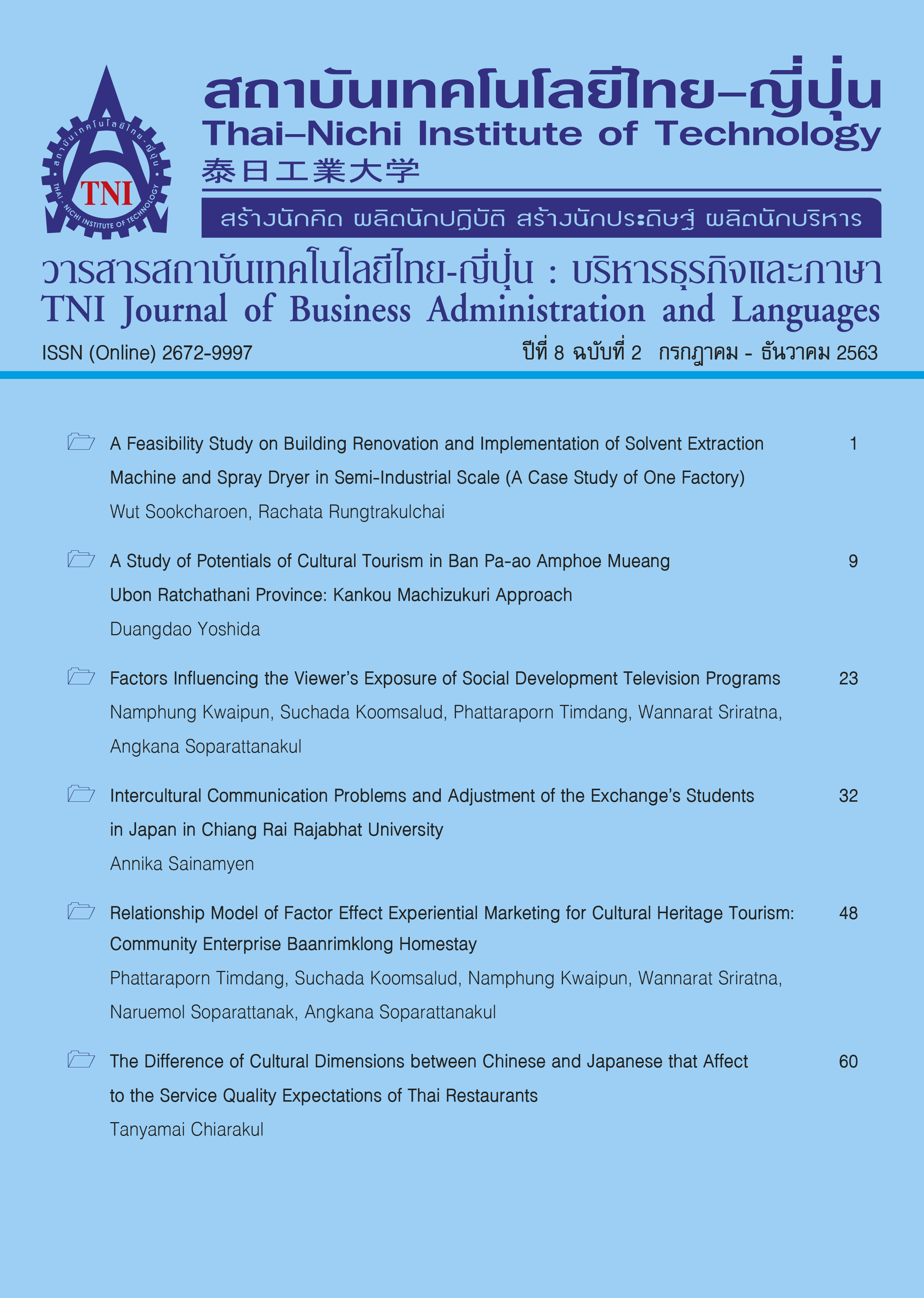A Study of Potentials of Cultural Tourism in Ban Pa-Ao Amphoe Mueang Ubon Ratchathani Province: Kankou Machizukuri Approach
Main Article Content
Abstract
This research study aims to; 1) Survey the tourism resources of “Ban Pa Ao” Village, Amphoe Mueang, Ubon Ratchathani, based on the concept of A Study of Potentials of Cultural Tourism in Ban Pa-ao Amphoe mueang Ubon Ratchathani Province: Kankou Machizukuri Approach. 2) To study both the comments and critiques, how public sectors, local business operators and current citizens reflecting back to the concept of A Study of Potentials of Cultural Tourism in Ban Pa-ao Amphoe mueang Ubon Ratchathani Province: Kankou Machizukuri Approach. This research is using qualitative method, with a total set of 12 structured interviews; given out to the public sectors, local business operators, and current citizens villagers of Ban Pa-Ao. Two criteria were set in order to divide those selected participants to both, survey to only specific participants and survey to participants participated based on their convenient, as this latter part analyzed solely on the information and data given. Results have shown: 1) The current useful tourism resources are; the Village Center of Brass and Silk, OTOP Souvenirs Center, “Chamlermraj” Center, and “Ban Pa Ao” Home-stay. 2) Tourism resources have acquired of potential development due to the exclusive characters of the local, with the combination of, the historical part, the local wisdom of Brass and Silk handicraft and the ebony “ma-kluea” dyed silk weaving in an orb patterned; all are in support to the experience tourism potential of the village community.
However, this research has also found out that the village is still lacking of potential for the part of community participation in tourism activities; marketing in tourism that has no variety and outdated. Thus, to do a marketing development, it is important to focus mainly on the need of the local; also Pa-Ao villagers have expressed their need for quality tourists, those who understand the local cultures and with power to spend.
Article Details
Article Accepting Policy
The editorial board of Thai-Nichi Institute of Technology is pleased to receive articles from lecturers and experts in the fields of business administration, languages, engineering and technology written in Thai or English. The academic work submitted for publication must not be published in any other publication before and must not be under consideration of other journal submissions. Therefore, those interested in participating in the dissemination of work and knowledge can submit their article to the editorial board for further submission to the screening committee to consider publishing in the journal. The articles that can be published include solely research articles. Interested persons can prepare their articles by reviewing recommendations for article authors.
Copyright infringement is solely the responsibility of the author(s) of the article. Articles that have been published must be screened and reviewed for quality from qualified experts approved by the editorial board.
The text that appears within each article published in this research journal is a personal opinion of each author, nothing related to Thai-Nichi Institute of Technology, and other faculty members in the institution in any way. Responsibilities and accuracy for the content of each article are owned by each author. If there is any mistake, each author will be responsible for his/her own article(s).
The editorial board reserves the right not to bring any content, views or comments of articles in the Journal of Thai-Nichi Institute of Technology to publish before receiving permission from the authorized author(s) in writing. The published work is the copyright of the Journal of Thai-Nichi Institute of Technology.
References
Chai Phothisita. (2011). Science and art of qualitative research. (in Thai). (2nd ed.). Bangkok: Amarin Printing.
Fongchan Luangchanduang, Surachai Kangwon, Waraporn Nantasan. (2018). The potential of role-model communities in sustainable and creative tourism. (in Thai). Electronic Journal of open and Distance Innovative Learning, 8(2), 52-83.
KIYOBI. (2019). Kabata: When life and water meet at Harie. Retrieved from https://anngle.org/th/j-culture/kabata.html
Nastasi, B. K. and Schensul, S. L. (2005). Contributions of qualitative research to the validity of intervention research. Journal of School Psychology, 43(3), 177-195.
Pa-ao Subdistrict Administrative Organization. (2019). Environment of Community. Retrieve from https://www.pa-ao.go.th/index.php/about-us/general
Pattra Jangjaicharoen. (2015). Cultural tourism management: A case study of Ogimachi community, Shirakawa Village, Gifu Prefecture, Japan. (in Thai). Japanese Studies Journal, 33(2), 79-97.
Pethakorn Sributwong. (2013). Old town love story from Japan. (in Thai). Bangkok: Bangkok Forum.
Prathana Jirachaiaree. (2013). The design of brass with silk products Baan Pa-ao Ubonratchathani (in Thai). (Master’s thesis, Silpakorn University). Retrieved from http://www.sure.su.ac.th/xmlui/bitstream/handle/123456789/13569/fulltext.pdf?sequence=2&isAllowed=y
Suatta BuraphaSathit chitphong. (2015). The guidelines for preserving and adding the value to the brass handicraft of Ban Pa-Ao, Pa-Ao Sub-district, Muang District, Ubonratchathani Province. (in Thai). Academic Journal Phranakhon Rajabhat University, 6(2), 48-61.
Supang Chantavanich. (2013). Qualitative research methods. (in Thai). (21th ed.). Bangkok: Chulalongkorn University.
Taku Nohara. (2008). Current situation and possibilities surrounding tourism town development Quarterly town development. (in Japan). Yokohama: Nihon Kotsu Corporation.
Tourism Town Development Promotion Council. (2004). Tokyo metropolitan tourism town development basic policy Tokyo. Retrieved from https://www.mlit.go.jp/kankocho/page04_000048.html
Tourism Town Development Study Group. (2000). Tourism town development guidebook. (in Japan). Japan: Asia-Pacific Tourism Exchange Center.


